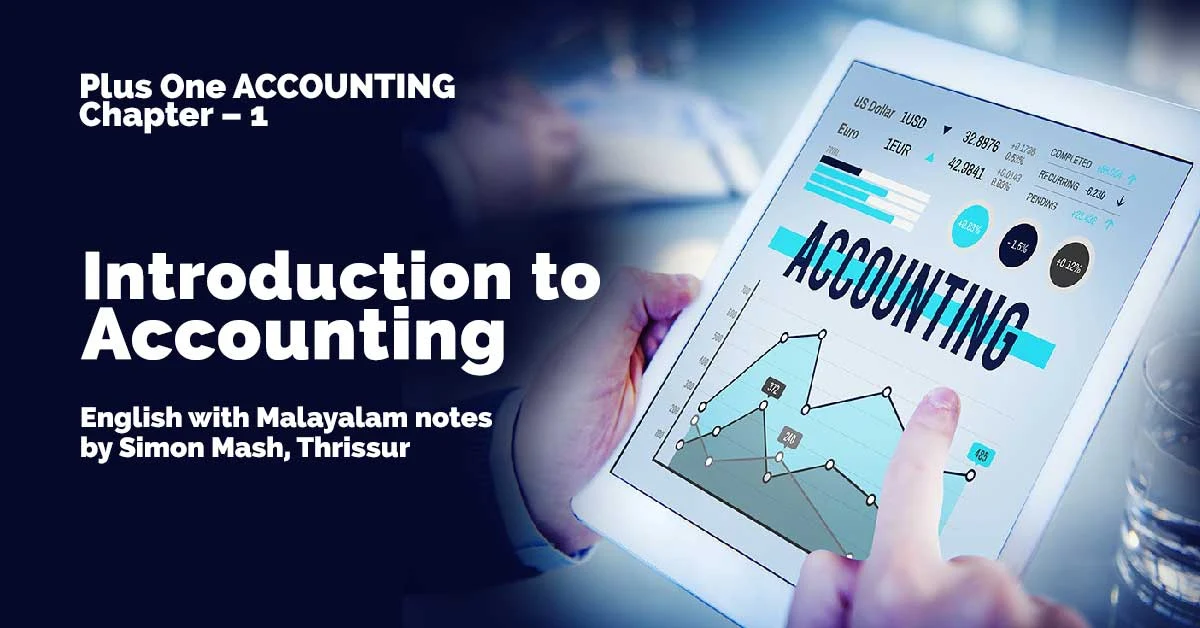Kerala Plus One Accountancy Notes Chapter 1
Introduction to Accounting
English with Malayalam Notes
Accounting:
It is an art of recording, classifying, summarizing, analyzing and
interpreting the business transactions and communicating the result to the
persons who are interested in such information.
ഒരു സ്ഥാപനത്തിലെ സാമ്പത്തിക ഇടപാടുകളെ ശാസ്തീയമായി രേഖപ്പെടുത്തുകയും,
തരംതിരിക്കുകയും ബിസിനസ്സിന്റെ ലാഭനഷ്ട കണക്കുകളും സാമ്പത്തികസ്ഥിതിയും
നിർണ്ണയിക്കുകയും അവ വിശകലനം ചെയ്ത് ആവശ്യമായ തീരുമാനങ്ങൾ കൈകൊള്ളുകയും
ചെയ്യുന്ന ഒരു കലയാണ് അക്കൗണ്ടിംഗ്.
Meaning and Definition of Accounting
According to the American Institute of Certified public Accountants (AICPA).
“Accounting is an art of recording, classifying and summarizing in a
significant manner and in terms of money, transactions and events which are,
in part, at least, of a financial character and interpreting the result
there of.
അമേരിക്കൻ ഇൻസ്റ്റിറ്റ്യൂട്ട് ഓഫ് സെർട്ടിഫൈഡ് പബ്ലിക് അക്കൗണ്ടൻസിന്റെ അഭിപ്രായമനുസരിച്ച് അക്കൗണ്ടിംഗിനെ നിർവ്വചിച്ചിരിക്കുന്നത് ഇങ്ങനെയാണ്: ധനകാര്യ സ്വഭാവമുള്ള ഇടപാടുകളെ പണത്തിന്റെ അടിസ്ഥാനത്തിൽ രേഖപ്പെടുത്തുകയും, വർഗീകരിക്കുകയും, സംഗ്രഹിക്കുകയും, അതിന്റെ ഫലം വ്യാഖ്യാനിക്കുന്നതുമായ ഒരു കലയാണ് അക്കൗണ്ടിംഗ്.
Qualitative Characteristics of Accounting Information:
(ഒരു നല്ല അക്കൗണ്ടിംഗ് റിപ്പോർട്ടിനുണ്ടായിരിക്കേണ്ട ഗുണങ്ങൾ)
1. Reliability:
(വിശ്വസനീയമായിരിക്കണം )
Accounting
information must be reliable. A reliable information should be free from
errors and bias and faithfully represent the information.
2. Relevance:
(സന്ദർഭത്തിന് യോജിച്ചതായിരിക്കണം)
The
accounting information should be relevant to the decision making needs of
the users. The information must be available in time.
3. Understand ability
(എളുപ്പത്തിൽ മനസിലാക്കാൻ
കഴിയുന്നതായിരിക്കണം)
The accounting information must be easily
understandable by users. The decision makers must interpret the accounting
information in the same sense as it is prepared and conveyed to them.
4. Comparability
(താരതമ്യം ചെയ്യാൻ
കഴിയുന്നതായിരിക്കണം)
The financial statement of an enterprise should be
comparable. It should facilitate inter-firm as well as intra-firm
comparison.
Basic Terms In Accounting
Assets:
Assets are things of value owned by the business
പണമൂല്യമുള്ള വസ്തുക്കളെയാണ് ആസ്തികൾ എന്നു പറയുന്നത്,
Eg: Land, Building, Furniture, Vehicles, etc.
Fixed Assets:
The assets which is intended to be used for long period (above one year).
ബിസിനസ്സിന്റെ ദീർഘകാല പ്രവർത്തനങ്ങൾക്ക് ആവശ്യമായി വരുന്ന ആസ്തികളെയാണ്
സ്ഥിരആസ്തികൾ എന്നു പറയുന്നത്.
Eg: Machinery, Land, Building etc.
a) Tangible Assets:
These are assets having definite shape and physical existence.
സ്ഥായിയായ രൂപവും ആകൃതിയുമുളള ആസ്തികൾ
b) Intangible Assets:
Assets having no physical existence but are represented by rights in certain
things.
സ്ഥായിയായ നിലനിൽപോ രൂപമോ ഇല്ലാത്തതും എന്നാൽ ചില അവകാശങ്ങളെ
സൂചിപ്പിക്കുന്നതുമായ ആസ്തികൾ,
Eg: Goodwill, Trademark, Patent, Copyright etc.
c) Wasting Assets:
Assets which gets exhausted to the extent of extraction.
ഉപയോഗിക്കുംതോറും തീർന്നുപോകുന്ന ആസ്തികൾ.
Eg: Mines, Quarries and Oilfields etc.
d) Fictitious Assets:
These have no real value but are shown in the books of accounts only for
technical reason.
യഥാർത്ഥത്തിൽ ഇപ്പോൾ വിലമതിക്കാത്തതും എന്നാൽ ചില സാങ്കേതിക കാരണങ്ങളാൽ കണക്കു
പുസ്തകങ്ങളിൽ ആസ്തിയുടെ രൂപത്തിൽ കാണിക്കുന്നതുമായ ആസ്തികൾ.
Eg: Preliminary expenses, discount on issue of shares and debentures,
underwriting commission etc.
Current Assets: are those assets which can be converted
into cash within a short period.
ഒരു വർഷത്തിനുള്ളിൽ പണമാക്കി മാറ്റാൻ കഴിവുള്ള ആസ്തികൾ,
Liabilities: are the obligations which a business owes to
others.
ബിസിനസ്സ് മറ്റുളളവർക്ക് കൊടുക്കാനുള്ള കടങ്ങൾ (ബാധ്യതകൾ).
Long term or Fixed Liabilities:
Liabilities which are payable after a long period (usually above one
year).
ദീർഘകാലംകൊണ്ട് ഒരു വർഷത്തിനു മുകളിൽ കൊടുത്തു തീർക്കേണ്ട ബാധ്യതകൾ,
Eg: Bank loan
Current Liabilities: Liabilities which are payable within a
short period (less than one year).
കുറഞ്ഞ സമയത്തിനുള്ളിൽ (ഒരു വർഷത്തിനുള്ളിൽ) കൊടുത്തു തീർക്കേണ്ട ബാധ്യതകൾ.
Capital: Money or money’s worth invested by the owner into
the business.
ബിസിനസ്സ് ആരംഭിക്കുന്നതിനുവേണ്ടി ഉടമസ്ഥർ ചെലവഴിച്ച തുക
Drawings: The amount of cash or other assets withdrawn by
the owner for his personal use.
മുതലാളിയുടെ സ്വന്തം ആവശ്യത്തിനുവേണ്ടി പണമോ മറ്റ് ആസ്തികളോ ബിസിനസ്സിൽ നിന്നും
എടുക്കുന്നതിനെയാണ് ഡ്രോയിങ് എന്നു പറയുന്നത്.
Voucher: It is the documentary evidence in support of a
transaction.
ബിസിനസ്സിൽ നടക്കുന്ന ഇടപാടുകൾക്കുള്ള പ്രാമാണികമായ തെളിവാണ്
Voucher. Revenues:
The amount earned by selling its products or services.
ഒരു സ്ഥാപനം അതിന്റെ ഉൽപന്നങ്ങളോ, സേവനങ്ങളോ വിൽക്കുമ്പോൾ കിട്ടുന്ന തുകയാണ്
വരുമാനം.
Expenses:
The amount spent for earning revenue.
വരുമാനം ഉണ്ടാക്കാൻ വേണ്ടി ചെലവഴിക്കുന്ന തുക
Eg: Salary, Interest, Rent etc Goods: Refers to commodities, products or
articles in which a trader deals.
ഒരു വ്യാപാരി വിൽപന നടത്തുന്നതിന് വേണ്ടി വാങ്ങുകയോ, ഉൽപാദിപ്പിക്കുകയോ
ചെയ്യുന്ന വസ്തുക്കൾ.
Purchases:
The amount of goods purchased by a business both for cash and credit and are
meant for sale.
വിൽക്കാൻ ഉദ്ദേശിച്ചുകൊണ്ട് പണത്തിനോ, കടത്തിനോ വാങ്ങിക്കുന്ന ചരക്കുകൾ.
Sales:
It is the revenue or income earned by a business through the sale of goods
and services.
സാധനങ്ങളാ സേവനങ്ങളോ ഉപഭോക്താക്കൾക്ക് നൽകുമ്പോൾ ലഭിക്കുന്ന വരുമാനം.
Purchase Returns (Returns outwards):
Return of goods to suppliers (purchased earlier).
വിതരണക്കാരുടെ പക്കൽ നിന്നും ഒരിക്കൽ വാങ്ങിയ സാധനങ്ങൾ അവർക്കുതന്നെ തിരിച്ചു
നൽകുന്നതിനെ പർച്ചേസ് റിട്ടേൺസ് എന്നു പറയുന്നു.
Sales Returns (Returns inwards):
Return of goods by the customer (sold earlier) to the business.
ഉപഭോക്താക്കൾക്ക് വിറ്റ ചരക്കുകൾ ചിലപ്പോൾ തിരിച്ച് ബിസിനസ്സിന് തന്നെ
നൽകുന്നതിനെ സെയിൽസ് റിട്ടേൺ എന്നു പറയുന്നു.
Debtors or Accounts receivables:
A debtor is a person who owes money to the business
ബിസിനസ്സിന് ഏതെങ്കിലും വ്യക്തികളോ, സ്ഥാപനങ്ങളോ പണം നൽകാനുണ്ടെങ്കിൽ അവർ
ഡെബ്റ്റർ എന്നു വിളിക്കുന്നു.
Creditors or Accounts payable:
A creditor is a person to whom the business owes money (on account of credit
purchase).
ബിസിനസ്സ് മറ്റുള്ള വ്യക്തികൾക്കോ, സ്ഥാപനങ്ങൾക്കാ പണം നൽകുന്നുണ്ടെങ്കിൽ അവരെ ക്രെഡിറ്റേഴ്സ് എന്നു വിളിക്കുന്നു.
Prepaid Expenses:
Expenses paid in advance.
ഭാവിയിൽ നൽകേണ്ട (അടുത്ത വർഷം) ഏതെങ്കിലും ചെലവുകൾ ഇപ്പോൾ തന്നെ (നടപ്പുവർഷം) നൽകുന്നതിനെ.
Eg: Prepaid rent, Prepaid insurance premium Outstanding
Expenses:
Expenses due but not pai ld.
ചെലവുകൾ നൽകാൻ സമയമായിട്ടും കൊടുത്തുവീട്ടാത്ത ചെലവുകൾ,
Eg: Salary outstanding, Rent outstanding etc.
Accrued Income:
Income due but not received.
ബിസിനസ്സിന് നടപ്പുവർഷം ലഭിക്കേണ്ടതും എന്നാൽ ഇതുവരെ ലഭിച്ചിട്ടില്ലാത്തതുമായ വരുമാനം.
Eg: Interest accrued, Commission accrued etc. Unearned Income: Income
received during the Period but it is applicable to the next period.
അടുത്ത വർഷം ലഭിക്കേണ്ട വരുമാനം നടപ്പുവര്ഷം മുൻകൂട്ടി ലഭിക്കുന്നു.
Eg: Unearned rent/rent received in advance.




